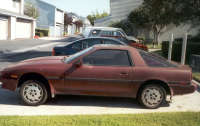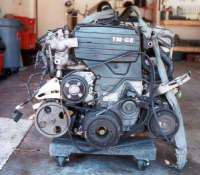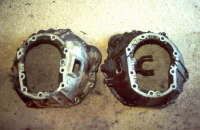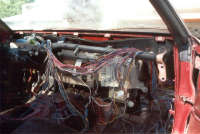I have spent a lot of time and money (at least on my budget) over the past couple of years to get my truck where it is today, and it is just about done- alright, the suspension will NEVER be completely done, but everything else I am pretty happy with. Except for one little thing -- power. Or, more precisely, the lack thereof.
While the Toyota 22-RE is a truly reliable powerplant, it doesn't exactly throw you back in your seat at take-off. Add 15 years and 230,000 miles of driving, and it is time for something better. There are quite a few options out there for increased power, including a rebuilt 22-RE by someone like RC Engineering or DOA, or a Chevy 4.3L V6 swap. However, as I've been researching different options I have realized that both of these have their drawbacks:

|
| The victim is this Toyota Supra, which houses an inline six cylinder. |
Another option, which has been gaining popularity in Toyota circles lately, is swapping in an engine from a Toyota Supra. The reason for this is that the engine will bolt directly to the Toyota truck transmission without any adapters, using the Supra bell housing.
In addition, since they are both Toyotas, the various accessories should be much easier to mate than those from another manufacturer. (I say should, because this swap is a multi-month project, which has yet to see completion.) Also, at 200HP stock, the Supra engine puts out about 40 more HP than the Chevy motor of a similar year, and still has room for growth. Add to that, the Supra's power-band hits at a higher RPM than the torqier Chevy V6, which is more suitable to my style of driving.
So, a decision has been made. Follow along with the progress over the next couple of months as we attempt to swap out my tired 4-cyl 22-RE with a low mileage 7M-GE. This month I will be introducing the swap as well as discussing several issues that will come up. Next month I will cover the swap itself, and the following month I will tie up any loose ends from the swap and give you my first impressions.
OVERVIEW
Engine -- Toyota first introduced the Supra in 1982 as a version of the Celica, designated the Celica Supra MKII. It came with an inline 6 cylinder engine (5M-GE) that put out around 155 HP. In 1986 ½, Toyota introduced the Supra MKIII, with an improved engine (7M-GE) that produced 200HP stock. A turbo version (7M-GTE) was also available that put out 230 HP. The 7M-GE was built until 1993, so donor vehicles are readily available. I plan on buying a high mileage donor car, and replacing the engine with a low mileage engine imported from Japan. For various reasons, in Japan it is cheaper to buy a new car than maintain an old one, so low mileage cars are purchased by importers and brought into the US. The cost for one of these engines, which are guaranteed to have less than 50K miles and come with a one year warranty, is significantly less than a rebuilt or remanufactured engine ($420 vs. $3000). They come with accessories for Japanese parts, so a complete donor vehicle is needed for all of the engine components (intake, alternator, water pump, etc.). I also need the wiring harness, ECU, bell housing, etc.
The 7M is reputed to be a typical Toyota motor- bulletproof and reliable. The only issue with this engine is head gasket problems, but from the information I have found this can easily be solved by increasing the head bolt torque from the factory recommended 58 ft/lbs. to around 70 ft/lbs., and checking them regularly. A great article on this can be found at:
http://www.supras.com/sogi/generations/mk3_pmtn.html

|
| This is a frontal view of the Supra's 7M-GE. It's fuel injected. |
Engine Mounts -- I don't know yet how I will mount the engine. I believe that the 7M mounts are in a very similar location to the 22RE mounts, and I am hoping I can just use an adapter plate. If not, I will have to fabricate custom brackets and weld them to the frame, and then use the Supra mounts.
Transmission -- I plan on keeping my stock Toyota 5-speed tranny (G52), which is very similar to the Supra tranny (W58). The bolt pattern for both transmissions is identical, so the Supra bell housing will bolt right up. It currently has over 225K miles on it, but I haven't had any problems with it at all. I don't know how much longer it will last, but I will deal with that when the time comes.
Clutch -- I am going to use the clutch, flywheel, and slave cylinder from the Supra. I plan on ordering a new clutch (Centerforce II) because the previous owner of the Supra thinks the clutch is the original one. Hopefully the flywheel is in good shape and I can just get it resurfaced. Since the slave cylinder is on the opposite side of the vehicle than it is currently, I will need to run a new line, but I plan on using the 4-Runner master cylinder.
Radiator/Cooling -- Since I am going from a 4 to 6 cylinder, I do need to upgrade the radiator. I could use the one from the Supra, but the engine had a bad head gasket, which means the entire cooling system is probably corroded. Also, I would have to fabricate custom mounts. When I was looking into swapping in a 4.3L Chevy motor, I was planning on using Downey's 3-core radiator made for that conversion. It is large enough, and is a direct bolt on to the stock mounts. I checked the inlet and outlet hoses, and it looks like they are in the correct positions. For fans, I will probably run dual electric pusher fans in front of the radiator. After the motor is in I will measure the clearance to see if I can fit them behind the radiator, but I doubt there will be room.

|
| The bell housings as well as the many other parts are identical. |
Engine Accessories (alt, H2O pump, p/s pump, etc.) -- I plan on using all Supra accessories and mate them (if applicable) to the truck components. I will probably replace many of these with rebuilt units, since the donor vehicle has high mileage and it will be easier to replace them with the engine out of the vehicle.
Fuel System -- I am going to keep the 4-Runner fuel tank, and the stock in-tank fuel pump. The specified fuel pressure for the 4-Runner is 33-38 PSI and 33-40 PSI for the Supra. I don't think that the extra 2 PSI will make a difference, but that is something I will have to find out.
Exhaust -- I am not sure exactly what I will do for the exhaust. I will probably keep the stock headers, and have a custom 2 ¼" exhaust made. The exhaust does exit the engine on the opposite side of the vehicle, so at some point it will need to cross over to the driver's side.
Misc. Issues -- There are several things about the swap that I am concerned about. The first is the wiring- I am not a wiring expert, so I think that will be one of the hardest parts of the swap. I am also worried about oil pan clearance with my front differential. There are two versions available- a front sump and rear sump. I hope that the rear sump may clear the front diff., but I will just have to wait and see. The others who have done this swap have had straight axles, so I may have to have a custom oil pan built. As far as I know, I may be the first person to try this with IFS. Another issue will be the length of the engine- because it is a straight six, it is longer that my 22RE. This will cause some issues with the fan and radiator, as well as with some of the engine accessories. I am sure MANY other issues will come up- hopefully they can all be figured out.
Here are some great links to Supra information and sites:
http://www.supras.com/sogi/sogi.phtml
http://www.kwcengine.com
Removal of Engine from Donor Supra
The donor vehicle chosen was a 1987 Supra with 180,000 miles and a blown head gasket which I picked up for $1200. The body and interior were trashed, but all I wanted was the engine/accessories and the wiring/ECU. While driving it home, I couldn't help but enjoy the power it had even with the high miles. I could not wait to get it in the 4-Runner! For the first couple of weeks it just sat in the driveway while started stockpiling all of the things I would need- factory service manual, new clutch, radiator, belts, etc. I also contacted K. Watanabe and ordered the low-mileage engine from Japan. When the service manual from Toyota finally came in, I could get started.

|
| The donor vehicle is packed tight with the straight six. |
The first step in removing the engine was to figure out the wiring. I knew this would probably be the most difficult part of the whole swap for me, so I wanted to take it slow and be very careful to label everything well. I took me the best part of a weekend to remove the complete dash area and expose the wiring harness. Using the wiring diagram in the service manual, I isolated the wires that I would need to keep attached to the engine harness/ECU and those that I could remove. This was actually easier than I had expected- the great majority of the wires in the harness are for interior electric's like power windows, locks, and things like that. Also, the Supra came with ABS which has it's own harness. The hardest part of the whole thing was separating everything enough so I could figure out where each wire went.
By the end, I was left with the engine harness attached to the ECU, and 16 wires that ran from the engine harness to the gauges, ignition switch, or No 1 fuse panel (in the driver's kick panel). There were also 2 wires that ran from the ECU to the fuel pump relay. Other than those 18 wires, the engine wiring harness/ECU could be removed as a complete, self-contained unit- the only thing needed to run the engine is to supply power to the harness and hook up the fuel pump relay. The 16 wires would need to be spliced into the 4-Runner's harness to provide info to the gauges, but were not necessary to run the engine.
Once I had removed the wiring harness, the removal of the engine was pretty straightforward. I drained the fluids, and removed the radiator, battery, and air cleaner. I also disconnected the power steering, air conditioning, and cooling hoses, and the fuel lines. Once I had everything disconnected, I attached the engine to a chain hoist I rigged up in my garage, and took the weight of the engine off the motor mounts. I then unbolted the mounts and attempted to crawl underneath to unbolt the tranny. This is where I ran into my first problem- the Supra sits about 6 inches off the ground (as opposed to a couple of feet for the 4-Runner), which made the whole "remove the tranny" thing a little bit harder than expected. I finally had to re-attach the motor mounts, jack up the front of the car, and take up the slack in the chain hoist again so I could re-unbolt the motor mounts. After that, I was able to remove the tranny easily (it is amazing how small they are without a transfer case) and remove the engine from the car.
Swapping Accessories to New(er) Engine

|
| Don't let this rat nest of wires fool you. There are only a few things you'll need for this swap. |
After I removed the engine from the donor Supra and mounted it to my engine stand, I ordered a low mileage Japanese engine from K. Watanabe. The cost was $420 and it came with a 1-year warranty, and was guaranteed to have less than 50K miles. When I picked it up I realized how different the accessories are in Japan. When I got it home and started comparing the two engines, I even thought they had given me the wrong one. All of the accessories looked different, the motor mounts were different, and the oil pan was the front sump type. I carefully compared the block and head, and realized that they were the same- however, I was going to have to swap over everything. I started by removing all of the accessories from the Japanese engine to get it down to a long block. After cleaning it really well, I started pulling accessories from the donor engine and installing them, cleaning them as I went along. The donor engine had not been well cared for, so I wanted to check everything out as I went along.
I ended up replacing the water pump, front and rear main seals, all 3 belts, as well as the distributor cap/rotor and of course new plugs and wires. The engine had come with a complete gasket set, so I had all of the correct gaskets to use. The intake manifold was pretty dirty, so I spent a lot of time with spray cleaner and a few old toothbrushes to get it as clean as I could. I also ended up replacing a lot of the hoses, as it was much easier to do with the engine out of the car. A couple of notes to anyone else doing this swap- the spark plugs and wires must be installed BEFORE the throttle body. I don't know who designed it that way, but it is impossible to access the three middle plugs with the throttle body installed. Also, it is much easier to attach the wiring harness while the engine it out- the harness runs between the intake manifold and the head, which makes it next to impossible to attach when the engine is installed.
Well, I am now at the point of no return. The 7M-GE is completely ready to be dropped into the 4-Runner, so the next step is to remove the 22-RE. I will have all of the details from the swap next month.
The Supra Swap - Part 1 Story - Photo Gallery 1
The Supra Swap - Part 2 Story - Photo Gallery 2
Join in the discussion at Off-Road.com's
Bulletin Board System and Mailing Lists


 Your Privacy Choices
Your Privacy Choices